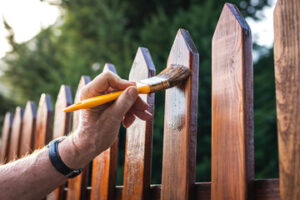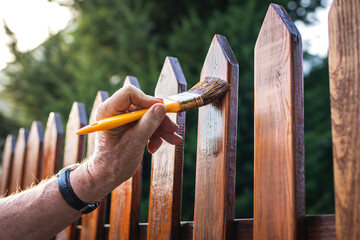Keeping your fence in good condition is important to the security of your property. Regular maintenance can prevent small problems from escalating into costly repairs.
The first step in maintaining your fence is to give it a thorough cleaning. Using a pressure washer will reduce scrubbing time and help to avoid wood discoloration from dirt. Contact R.C Fence LLC to check your fence.
 Check The Pickets
Check The Pickets
When a fence picket is damaged, it is important to repair the damage quickly to prevent the problem from spreading. This is especially true for vinyl fencing, where even seemingly minor cracks and chips in the vinyl can cause bigger issues later on. For example, water can get into the cracks in the summer and freeze in the winter, which can weaken the vinyl and cause more damage.
In most cases, fixing a single picket is not very difficult. It is usually a matter of unscrewing it, replacing it with a new one, and then screwing it back into place. However, in some cases, it may be necessary to replace the entire panel of the fence. This is more common for wood fences than vinyl, as it can be harder to find replacement pieces for wood fences, but a quick inspection by a professional can help determine what needs to be done and when.
It is also important to inspect for any damage that can affect the overall structure of the fence. Look for things like twisted and bent boards, misaligned posts, and rotting wood. Oftentimes, these problems can be fixed easily and cost-effectively by a professional.
Another thing to look for is any dents or holes in the wood. These are usually caused by rot, which can lead to structural problems with the fence. If the rot is severe, it may need to be replaced with a new piece.
A final step that should be taken regularly is to apply a sealant to the fence. This helps to keep moisture out of the wood, which can prolong its life. This is especially important in locations with a lot of rainfall or humidity.
For most people, the easiest way to do a maintenance check on their fence is simply to walk around it. This allows them to see if there are any problems with the fence, such as leaning or warped posts, loose pickets, or any other signs of wear and tear. By catching these problems early, they can be repaired before they become worse and save themselves the trouble of having to replace the entire fence later on.
Inspect The Posts
Often, fence posts become damaged from weathering, wind, and even vandalism. A rotting post can take down an entire fence, so it’s crucial to inspect your fencing regularly. During your inspection, look for any signs of damage such as a sagging section or loose boards. Detecting and addressing these problems early on will prevent them from getting worse.
Start by walking along your entire fence line and examining each panel for any issues. If you notice any damage, write down the areas so you can plan repairs. Once you’ve done your inspection, gather the necessary tools and materials. This will likely include a hammer, drill with drill bits, saw, wood glue or epoxy, and replacement boards/posts/pickets.
You’ll also want to check the cap of each post to ensure it is securely attached. If it isn’t, the cap may fall off during a storm and leave the post exposed to the elements. This can cause serious damage and could be dangerous for people or animals.
While you’re at it, check for any loose pickets or panels. If there are any, pound the nails back into place or use wood glue to reinforce them. Look for any sagging sections that need to be braced with stakes or concrete spurs.
If a board has cracked or split, apply some waterproof wood glue and tape it together for 24 hours. If the split is in a high-traffic area, consider replacing it with a new piece of wood.
When checking for damage, make sure to look for rot, insect infestations, and loose boards. These are all easy to spot and can be repaired quickly. If left unchecked, these issues can lead to costly repairs.
Lastly, remember to paint or stain your fence regularly. Staining and painting help protect the wood from sun and weather-related discoloration and fading. This will keep the wood from deteriorating faster and extend its lifespan.
Inspect The Hardware
If the hardware isn’t secure, your fence won’t be able to hold up to the elements or resist pressure from animals, children, or other people. Inspect the hardware every time you perform a routine inspection to make sure all of the components are intact and free from damage.
Start by examining the fence for any signs of damage, such as broken boards or loose pickets. Look for areas where the fence is leaning and check to see if any of the posts are showing signs of rot. Examine the area around the base of each post as well to ensure that the soil is not soggy and that the fence post is firmly seated in the ground.
Next, closely inspect the wood for signs of warping, insect damage, or rot. While some minor warping, cracks, or knots are normal and part of the weathering process, if there is significant damage to the wood, you may need to replace it.
Whether you have a metal or wooden fence, examine the hinges and locks to make sure that they are functioning properly. If they are squeaking, it is easy to fix by applying lubricant to the hinges. This is an inexpensive way to make your fence quieter and prevent ongoing damage from excessive noise.
If you have a chain link fence, carefully inspect the mesh to ensure that it is not damaged. Look for snags and bent sections of the chain link that can be fixed by rolling the mesh back into place or straightening it with pliers. If you have a self-closing gate, it is important to ensure that the latch is working correctly so that it closes properly every time. If it doesn’t, it may need to be adjusted by adjusting the screw within the latch mechanism.
If your fence has any signs of rust, it’s a good idea to treat it with a rust inhibitor. This can be purchased at most home improvement stores or online. The treatment is easy to apply and will help to protect the fence from further damage from moisture, sun, and wind.
Clean The Fence
A wood fence requires regular cleaning to keep it looking good and preventing deterioration. Many homeowners clean their fences by hosing them down with water. This works for minor dirt buildup and stains, but it is not as effective as a professional cleaning service.
Using a pressure washer is the best way to clean a fence. You can rent a power washer at home improvement stores, and they can be used for any kind of wood fence. You can also purchase a cleaning solution designed specifically for fences to make the process go much faster. If you are using a pressure washer, it is important to follow the manufacturer’s instructions for use. You should also cover any plants that are near the fence to protect them.
If you don’t have a pressure washer, you can still wash your fence by hand. This will take more time, but it is still better than letting the grime build up and become more difficult to remove later. To do this, get a bucket of water and add a small amount of detergent. Mix the solution until it is sudsy and apply it to your fence with a stiff bristle brush. Make sure to scrub all sides of your fence and between the pickets. Rinse the fence after you are finished and allow it to dry completely.
For more severe stains, you can try chlorine bleach. This will help to remove mold and mildew from your fence as well as hard water stains and rust. It is important to note that you should use this only when necessary, as bleach can kill grass and other vegetation, so it needs to be applied in a very controlled manner. To apply chlorine bleach to your fence, you can either pour it directly onto the area of the stain or mix it with water and pour it on.
Staining, painting, or sealing your fence is an important step in maintaining it. It will help to prevent rot, mold, and other forms of damage from the sun, moisture, and wind. It is recommended that you stain your fence at least once every three years.


